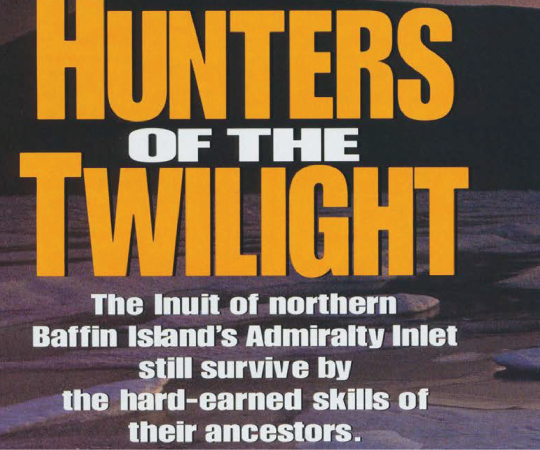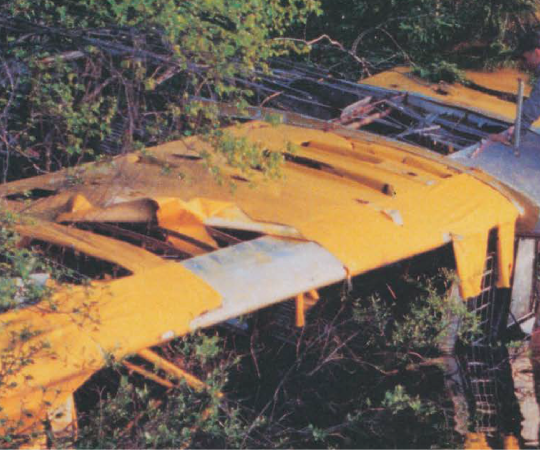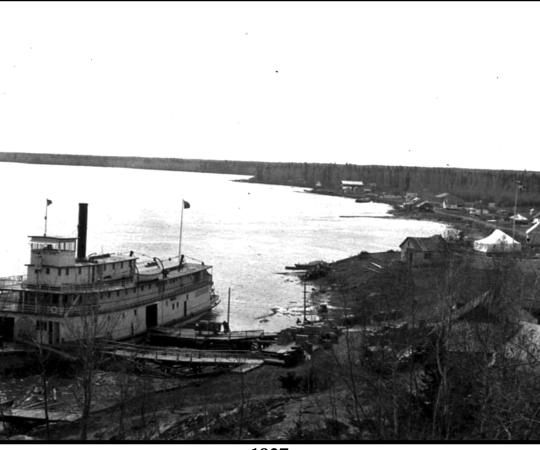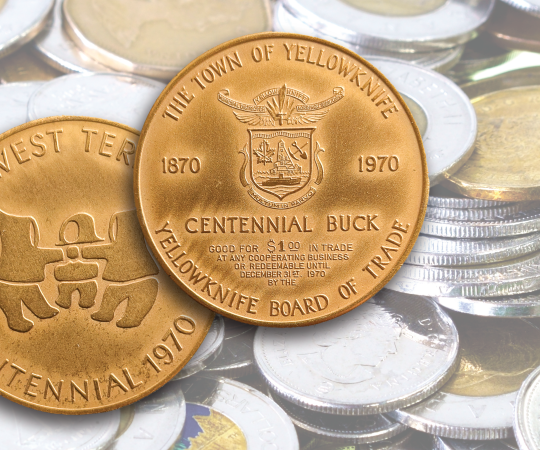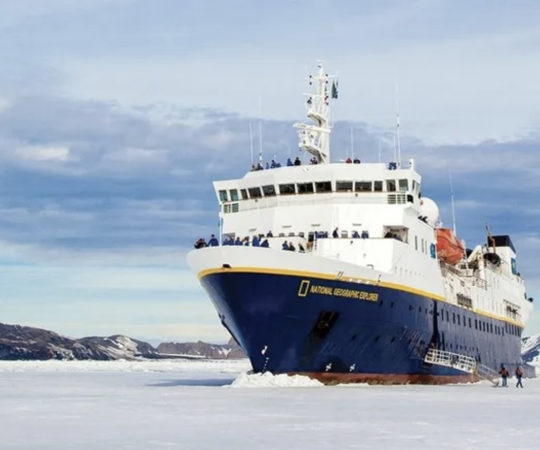
The bad news came down on payday: September 8, 1942. On Outpost Island, an eruption of land off the southern shore of Great Slave Lake, mine manager J.J. Byrne called a meeting and told his men the operation was shutting down. The paycheques that had bounced the month before? That was no accident, and there would be no September payroll, either. Worst of all, he told the assembled workers, there was no money to evacuate.
With freeze-up on the horizon, and supplies running low, a few dozen men, women and children were stranded on a remote island in the vast, unforgiving expanse of Great Slave Lake. It shouldn’t have come as a surprise; almost nothing ran smoothly at Outpost Island. The mine itself was less than two years old. The island, one of a cluster at the far western end of the lake’s East Arm, just north of Fort Resolution, had seen exploration crews coming and going in the mid-1930s, when encouraging traces of gold had been found. A new owner, Slave Lake Gold Mines Limited, began construction on a mill and mine site in 1940. Along the way, tungsten was discovered alongside the gold, sweetening the mine’s potential: The rare metal was essential to the ongoing war effort. Buildings rose; workers were flown or ferried in.
Production began on February 1, 1941. By July, Outpost Island was processing 50 tonnes of ore every day. But problems began to crop up almost immediately. On July 10, 1941, the president of Slave Lake Gold Mines Limited, Arthur P. Earle, wrote an ominous letter to shareholders about a possible takeover bid from another company, the Garfield Trading Corporation of Toronto. “If they succeed in their quest,” he wrote, “it might easily result in the complete collapse of the company.” The mine crews on site were loyal to managing director J.J. Byrne, he said; they were skilled, in-demand workers who would walk off the job if control of the operation changed hands. “A state of emergency exists and I appeal to all shareholders to come to the aid of the party in order to safeguard their own interests.”
Five days later, a major shareholder fired back: “I have confidence that this property, under proper management, will be a very profitable producer and its shares appreciate in value,” wrote Seward N. Lawson to the company’s backers. “I think that a change in management should be made. Mr. Bryne [sic] is not the only one in Ontario who can run a mining company … Further, I am satisfied that the crew of some 55 men at this property will not leave their work like a flock of sheep as indicated by Mr. Earle.”
Meanwhile, back at the mine, the workers knew all about the shareholder drama. On August 14, a miner named Max King wrote a letter to his friend Archie Jamieson, a former Outpost Island employee. “Things are in an uproar here right now,” King wrote. “I suppose you heard all about the row in Toronto, and that Jerry handed in his resignation … I suppose Walter will be going at the end of the month, and Art is talking of going out in early September, so perhaps this place isn’t just like ‘one big happy family,’ eh?” He added: “This place is really getting me down.”
By September, the dust was settling in Toronto. A new president and board of directors had signed on, and a statement had been issued to shareholders expressing the new board’s confidence in the management team and mining crew at the site. In the wake of the “uproar,” the mine muddled along until April 1942, when, one miner observed, “it began to slacken down.”
Efforts to locate more and higher-grade ore were failing. By June, the island crew got their first red flag: The ice had broken up on the lake and boats had free passage to the mine once more, but badly needed supplies still weren’t coming in. Miner Arthur Dion became anxious. “I spoke to Byrne different times about this and he kept putting me off saying they were coming on the next boat,” he said in a statement to the Fort Smith RCMP that fall.
In August, the cheques began bouncing. On September 8, Byrne broke the bad news.
Four days later, knowing that once freeze-up began they’d be cut off entirely, some of the men began to devise a radical solution. The residents of Outpost Island were no strangers to transit difficulties. Over the mine’s short lifetime, they’d occasionally been stranded for days at a time when planes – whether on floats or on skis – couldn’t land. They also knew the lake was not insurmountable. They were just 65 kilometres from Fort Resolution, and 94 kilometres from Yellowknife – in good weather, the men had canoed to the big city during their time off. And so they decided to build themselves a barge to make their escape. They no longer owed Slave Lake Gold Mines Limited any loyalty: They dismantled buildings and pillaged the remaining supplies to build their craft, which they christened the Stinky D. “All the material used was company stuff,” said Dion. “We equipped the barge with a 40 H.P. Buda motor and we got enough gas and grub to take us out.” They set sail on September 24, 1942, with 20 men, three women and two children aboard. Great Slave can be a violent, menacing lake, but the weather held and the Stinky D crossed the open expanse of water to Fort Resolution without incident. From there, the miners barged upriver to Fort Smith. They’d originally planned to carry on all the way south to Alberta, but many of them landed jobs en route – with Imperial Oil, or with a construction firm working along the CANOL pipeline – and so they stayed put.
Arthur P. Earle, it seemed, had been correct about one thing at least: His miners were a skilled and resourceful bunch, and neither esoteric backroom dealings in Toronto nor the more tangible obstacle of the dark waters of Great Slave Lake could keep them down.
 The bad news came down on payday: September 8, 1942. On Outpost Island, an eruption of land off the southern shore of Great Slave Lake, mine manager J.J. Byrne called a meeting and told his men the operation was shutting down. The paycheques that had bounced the month before? That was no accident, and there would be no September payroll, either. Worst of all, he told the assembled workers, there was no money to evacuate.
With freeze-up on the horizon, and supplies running low, a few dozen men, women and children were stranded on a remote island in the vast, unforgiving expanse of Great Slave Lake. It shouldn’t have come as a surprise; almost nothing ran smoothly at Outpost Island. The mine itself was less than two years old. The island, one of a cluster at the far western end of the lake’s East Arm, just north of Fort Resolution, had seen exploration crews coming and going in the mid-1930s, when encouraging traces of gold had been found. A new owner, Slave Lake Gold Mines Limited, began construction on a mill and mine site in 1940. Along the way, tungsten was discovered alongside the gold, sweetening the mine’s potential: The rare metal was essential to the ongoing war effort. Buildings rose; workers were flown or ferried in.
Production began on February 1, 1941. By July, Outpost Island was processing 50 tonnes of ore every day. But problems began to crop up almost immediately. On July 10, 1941, the president of Slave Lake Gold Mines Limited, Arthur P. Earle, wrote an ominous letter to shareholders about a possible takeover bid from another company, the Garfield Trading Corporation of Toronto. “If they succeed in their quest,” he wrote, “it might easily result in the complete collapse of the company.” The mine crews on site were loyal to managing director J.J. Byrne, he said; they were skilled, in-demand workers who would walk off the job if control of the operation changed hands. “A state of emergency exists and I appeal to all shareholders to come to the aid of the party in order to safeguard their own interests.”
Five days later, a major shareholder fired back: “I have confidence that this property, under proper management, will be a very profitable producer and its shares appreciate in value,” wrote Seward N. Lawson to the company’s backers. “I think that a change in management should be made. Mr. Bryne [sic] is not the only one in Ontario who can run a mining company … Further, I am satisfied that the crew of some 55 men at this property will not leave their work like a flock of sheep as indicated by Mr. Earle.”
Meanwhile, back at the mine, the workers knew all about the shareholder drama. On August 14, a miner named Max King wrote a letter to his friend Archie Jamieson, a former Outpost Island employee. “Things are in an uproar here right now,” King wrote. “I suppose you heard all about the row in Toronto, and that Jerry handed in his resignation … I suppose Walter will be going at the end of the month, and Art is talking of going out in early September, so perhaps this place isn’t just like ‘one big happy family,’ eh?” He added: “This place is really getting me down.”
By September, the dust was settling in Toronto. A new president and board of directors had signed on, and a statement had been issued to shareholders expressing the new board’s confidence in the management team and mining crew at the site. In the wake of the “uproar,” the mine muddled along until April 1942, when, one miner observed, “it began to slacken down.”
Efforts to locate more and higher-grade ore were failing. By June, the island crew got their first red flag: The ice had broken up on the lake and boats had free passage to the mine once more, but badly needed supplies still weren’t coming in. Miner Arthur Dion became anxious. “I spoke to Byrne different times about this and he kept putting me off saying they were coming on the next boat,” he said in a statement to the Fort Smith RCMP that fall.
In August, the cheques began bouncing. On September 8, Byrne broke the bad news.
Four days later, knowing that once freeze-up began they’d be cut off entirely, some of the men began to devise a radical solution. The residents of Outpost Island were no strangers to transit difficulties. Over the mine’s short lifetime, they’d occasionally been stranded for days at a time when planes – whether on floats or on skis – couldn’t land. They also knew the lake was not insurmountable. They were just 65 kilometres from Fort Resolution, and 94 kilometres from Yellowknife – in good weather, the men had canoed to the big city during their time off. And so they decided to build themselves a barge to make their escape. They no longer owed Slave Lake Gold Mines Limited any loyalty: They dismantled buildings and pillaged the remaining supplies to build their craft, which they christened the Stinky D. “All the material used was company stuff,” said Dion. “We equipped the barge with a 40 H.P. Buda motor and we got enough gas and grub to take us out.” They set sail on September 24, 1942, with 20 men, three women and two children aboard. Great Slave can be a violent, menacing lake, but the weather held and the Stinky D crossed the open expanse of water to Fort Resolution without incident. From there, the miners barged upriver to Fort Smith. They’d originally planned to carry on all the way south to Alberta, but many of them landed jobs en route – with Imperial Oil, or with a construction firm working along the CANOL pipeline – and so they stayed put.
Arthur P. Earle, it seemed, had been correct about one thing at least: His miners were a skilled and resourceful bunch, and neither esoteric backroom dealings in Toronto nor the more tangible obstacle of the dark waters of Great Slave Lake could keep them down.
The bad news came down on payday: September 8, 1942. On Outpost Island, an eruption of land off the southern shore of Great Slave Lake, mine manager J.J. Byrne called a meeting and told his men the operation was shutting down. The paycheques that had bounced the month before? That was no accident, and there would be no September payroll, either. Worst of all, he told the assembled workers, there was no money to evacuate.
With freeze-up on the horizon, and supplies running low, a few dozen men, women and children were stranded on a remote island in the vast, unforgiving expanse of Great Slave Lake. It shouldn’t have come as a surprise; almost nothing ran smoothly at Outpost Island. The mine itself was less than two years old. The island, one of a cluster at the far western end of the lake’s East Arm, just north of Fort Resolution, had seen exploration crews coming and going in the mid-1930s, when encouraging traces of gold had been found. A new owner, Slave Lake Gold Mines Limited, began construction on a mill and mine site in 1940. Along the way, tungsten was discovered alongside the gold, sweetening the mine’s potential: The rare metal was essential to the ongoing war effort. Buildings rose; workers were flown or ferried in.
Production began on February 1, 1941. By July, Outpost Island was processing 50 tonnes of ore every day. But problems began to crop up almost immediately. On July 10, 1941, the president of Slave Lake Gold Mines Limited, Arthur P. Earle, wrote an ominous letter to shareholders about a possible takeover bid from another company, the Garfield Trading Corporation of Toronto. “If they succeed in their quest,” he wrote, “it might easily result in the complete collapse of the company.” The mine crews on site were loyal to managing director J.J. Byrne, he said; they were skilled, in-demand workers who would walk off the job if control of the operation changed hands. “A state of emergency exists and I appeal to all shareholders to come to the aid of the party in order to safeguard their own interests.”
Five days later, a major shareholder fired back: “I have confidence that this property, under proper management, will be a very profitable producer and its shares appreciate in value,” wrote Seward N. Lawson to the company’s backers. “I think that a change in management should be made. Mr. Bryne [sic] is not the only one in Ontario who can run a mining company … Further, I am satisfied that the crew of some 55 men at this property will not leave their work like a flock of sheep as indicated by Mr. Earle.”
Meanwhile, back at the mine, the workers knew all about the shareholder drama. On August 14, a miner named Max King wrote a letter to his friend Archie Jamieson, a former Outpost Island employee. “Things are in an uproar here right now,” King wrote. “I suppose you heard all about the row in Toronto, and that Jerry handed in his resignation … I suppose Walter will be going at the end of the month, and Art is talking of going out in early September, so perhaps this place isn’t just like ‘one big happy family,’ eh?” He added: “This place is really getting me down.”
By September, the dust was settling in Toronto. A new president and board of directors had signed on, and a statement had been issued to shareholders expressing the new board’s confidence in the management team and mining crew at the site. In the wake of the “uproar,” the mine muddled along until April 1942, when, one miner observed, “it began to slacken down.”
Efforts to locate more and higher-grade ore were failing. By June, the island crew got their first red flag: The ice had broken up on the lake and boats had free passage to the mine once more, but badly needed supplies still weren’t coming in. Miner Arthur Dion became anxious. “I spoke to Byrne different times about this and he kept putting me off saying they were coming on the next boat,” he said in a statement to the Fort Smith RCMP that fall.
In August, the cheques began bouncing. On September 8, Byrne broke the bad news.
Four days later, knowing that once freeze-up began they’d be cut off entirely, some of the men began to devise a radical solution. The residents of Outpost Island were no strangers to transit difficulties. Over the mine’s short lifetime, they’d occasionally been stranded for days at a time when planes – whether on floats or on skis – couldn’t land. They also knew the lake was not insurmountable. They were just 65 kilometres from Fort Resolution, and 94 kilometres from Yellowknife – in good weather, the men had canoed to the big city during their time off. And so they decided to build themselves a barge to make their escape. They no longer owed Slave Lake Gold Mines Limited any loyalty: They dismantled buildings and pillaged the remaining supplies to build their craft, which they christened the Stinky D. “All the material used was company stuff,” said Dion. “We equipped the barge with a 40 H.P. Buda motor and we got enough gas and grub to take us out.” They set sail on September 24, 1942, with 20 men, three women and two children aboard. Great Slave can be a violent, menacing lake, but the weather held and the Stinky D crossed the open expanse of water to Fort Resolution without incident. From there, the miners barged upriver to Fort Smith. They’d originally planned to carry on all the way south to Alberta, but many of them landed jobs en route – with Imperial Oil, or with a construction firm working along the CANOL pipeline – and so they stayed put.
Arthur P. Earle, it seemed, had been correct about one thing at least: His miners were a skilled and resourceful bunch, and neither esoteric backroom dealings in Toronto nor the more tangible obstacle of the dark waters of Great Slave Lake could keep them down.


